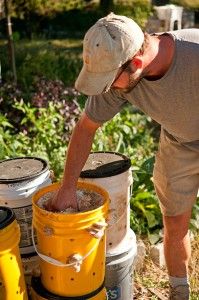Spread the Fungal Love

September 5, 2013
There’s a season for everything. So it should be no surprise that when it comes to mushrooms, one southern Illinois man has mushroom growing and hunting down to a science.
Michael “Mike” Hatfield is the owner of the Flyway Family Farm, a habitation that organically grows and provides many diverse and nutrient dense gourmet mushrooms, along with a variety of organic vegetables. Hatfield has had an interest in the production of mushrooms for the past 10 years; his business has generated commercially in full sway for two years.
Advertisement
Hatfield said those searching for Morel mushrooms in the spring might have a difficult time.
“[Morels] are good, but they’re also hard to find,” he said. “I started learning that there are far more edible mushrooms out in the fall and early winter than there is in the spring, and oyster mushrooms are one of the big ones and they’re really good.”
Hunters might be better off searching for mushrooms now rather than later in the year, he said.
“In the late summer and fall is when the Lion’s Mane’s grow, which are these giant … big white things with tentacles that kind of hang down, they almost taste like lobster, and those are great,” he said.
Hatfield said he became acquainted with mushrooms while in school about eight years ago.
“I just so happened to meet a guy who was growing Shi’take mushrooms, he had brought this big Shi’take in and I said ‘Wow, that’s awesome,’” he said.
Hatfield’s interest was piqued and he visited the man’s farm to learn about his other mushroom varieties.
Advertisement*
“I started messing around with Shi’takes and then started doing some oyster mushrooms, too,” he said. “And it’s been a steep learning curve ever since… But it has been fun and rewarding, that’s for sure.”
Hatfield has taken to growing his own mushrooms. The growing process consists of pieces of hardwood timber that have been stacked to reduce contamination from the soil before full colonization, and to expose more of the log so that more mushrooms have the chance to grow. The logs then have many holes drilled throughout their length and each hole filled with mushroom spawn.
“The way we’re doing it, there is not really a ‘processing’ of them,” he said. “[I] just pull it off and they usually come off pretty clean, occasionally there’s a little piece of bark that’s stuck on it and we’ll just pull that off the stem.”
When dealing with his oyster mushrooms, he has developed a different method. He has five gallon buckets, or in another instance long tube-cut cellophane bags, with holes respectively drilled or cut into them that are filled with shredded wheat straw and hydrated lime, along with the necessary mushroom spawn.
“We grow (oysters) in a way that encourages them to form clusters and we just pop them right off of the tubes that we’re growing them in,” he said.
He will soak the straw for up to 24 hours in caustic water, with a basic ph level of 12, before ingraining it into bags, or buckets, with the spawns.
“That super high ph, with (the mushrooms) soaking in there, pretty much kills other molds or bacteria, anything that might be growing on that straw and leaves it ready,” he said. “It gives us about a two week window where nothing is going to be growing on that straw except for the spawn that we put in there.”
Hatfield said these mushrooms can be used extensively to help the human body. — Some varieties can be brewed in teas and some even have medicinal effects to help treat arthritis and cancer. Mushrooms also are able to grow in a diverse range of areas.
“They’ll grow on just about any sort of agricultural waste, anything with cellulose in it,” he said. “So you can grow them on shredded newspaper, human hair, coffee grounds, rice straw, wheat straw, corn stalks, just about anything.”
Advertisement








